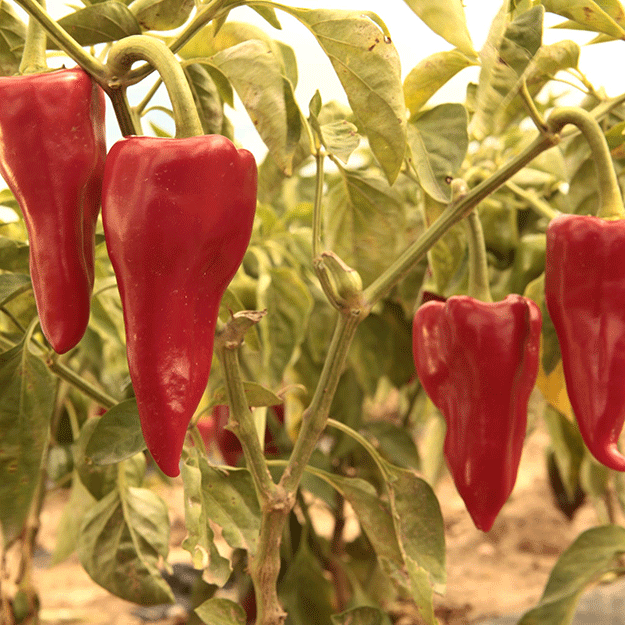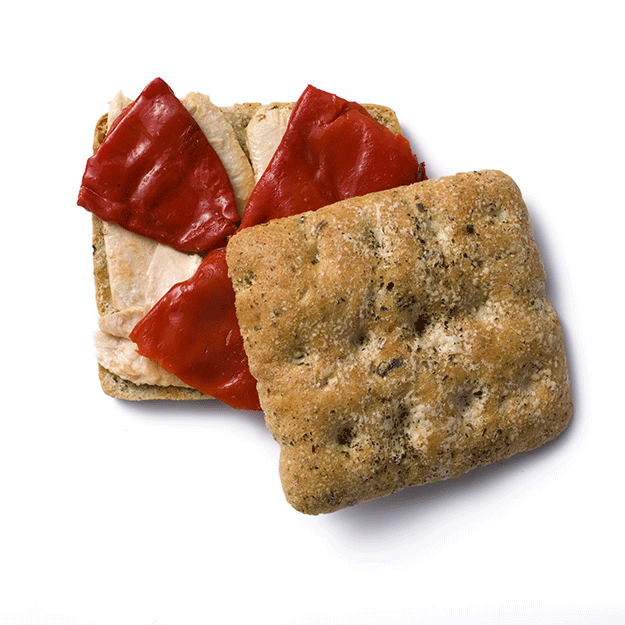.png.transform/rendition-xs/image_image%20(1).png)
The Perfect Piquillo Pepper
The Piquillo Pepper is often referred to as the ‘red gold’ of Lodosa. It has been sold outside its homeland only for a few decades. A treasure on the Spanish menu, it is slowly finding its way to countries outside Spain.

Text: Emmie Declreck/@ICEX
A long time ago, Christopher Columbus brought the first peppers to Europe from South America. These peppers, once planted in Spain, developed their own characteristics and turned into native Spanish varieties. Most of these grow in the south and the Mediterranean, but among that great collection of Spanish peppers - as Spain is one of the world’s main producers - there is also a special northern variety called ‘Piquillo Pepper’. Its homeland is Navarre, and more specifically, the surroundings of the town of Lodosa, after which its Designation of Origin is named.
Peppers handled with care
The ‘Pimiento de Piquillo de Lodosa’ is a slightly piquant, bright red pepper with a sweet touch. ‘Piquillo’ is the Spanish word for ‘little beak’, as these small, red peppers are shaped like the beak of a bird. They are harvested by hand between September and December.
The peppers get their sweet, slightly spicy flavour from being roasted over embers or open fires. They are then peeled and de-seeded by hand, before being packed in their own juices into jars or tins for sale. Pure Piquillos have been produced for generations almost entirely by hand, using no chemicals in the roasting or peeling process.
Bold but subtle
As often happens with local products of extraordinary quality, this peculiar pepper started off as a ‘home-made’ pepper, for personal consumption only. It was not until the end of the sixties that Lodosa, like many other villages of the Ebro Valley, became the favourite summer spot of many families of neighbouring communities. That is how the Piquillo pepper became known to people from outside the Valley, and word-to-mouth advertising ensured holidaymakers took home at least a few jars at the end of their holiday. The delicate pepper soon gained a mythical fame and prestige, and today it is one of those top-quality local ingredients Spanish chefs love to brighten their dishes up with, whether it is soup, salad or the main course. The bold but subtle pepper has become the perfect finishing touch in cuisine, as it is both colourful and full of flavour.
What also makes the triangular peppers very popular in the kitchen, is that they are shaped like little bags. That is why they are typically stuffed with meat, seafood or fish. A very traditional recipe in the north is Piquillo pepper filled with codfish; as is the case with the Spanish ‘ham and béchamel croquettes’, the pepper is equally filled with codfish in béchamel sauce. Other combinations that work well are peppers with tuna or crustaceans. They are very often used as garnish as well, especially with meat.
The label should say ‘Lodosa’

The Piquillo Pepper has had its Designation of Origin since 1987. As the quality of this product is so closely connected to its roots, it is important for consumers to recognise this seal of authenticity, which is granted only to those peppers that have been handpicked in the Ribera del Ebro region of Northern Spain. There are, after all, other varieties on the market.
Between 1994 and 1996 the seeds of the famous Piquillo pepper were exported to Peru, where they were planted by Peruvian businessmen. This kind of competition on the global market can cause confusion. Deceptive labelling by using the ‘Navarra’ brand for peppers which actually originate from Peru or China, tricks the consumer into believing that he is buying the famous pepper everyone automatically associates with Lodosa and the Designation. However, the authentic Piquillo peppers of Lodosa are only those with the label of the Regulatory Council, and so ‘Lodosa’ should be explicitly mentioned as well. These artisanal peppers are a bit more pricey, but their quality is unique and absolutely worth paying for.
Exporting the Piquillo Pepper
The Piquillo Pepper, once brought to Spain from America, is now finding its way back into the continent overseas and other countries. Conservas Pedro Luis, one of the main exporters of Piquillo Pepper, has had the Piquillo Pepper sent over to the United States for several years and also sells this prestigious pepper to Australia, Italy, France and Belgium, among others. “Our clients in Australia and the United States are mainly companies who specialise in Spanish products, distributing them to restaurants and catering companies. They are the kind of customers who are specifically looking for Spanish products with a Designation of Protected Origin. Apart from Piquillo Pepper, we export two more PDO products, Asparagus of Navarre and Tudela Artichoke”, explains Pedro Luis, the owner of the company. In France and Italy, for example, he can distribute the Piquillo Pepper to smaller companies as well.
The main problem he encounters, however, is that it can take a lot of time and effort to convince a potential customer of the superior quality of an artisanal PDO Piquillo Pepper when there are cheaper peppers from China and Peru on the market. “As the peppers are roasted and then peeled, they aren’t washed in water as this reduces their flavour. However, washing is a standard part of the process in other countries thus adversely affecting the quality and flavour of the produce. Their produce is much more automated. Our climate and variety also favours superior quality.”
Pedro Luis also receives orders from other countries through his website, often from clients who are looking for Spanish organic produce. “This works very well in France, where our tinned organic creams of soup or vegetable stews, for example, are in high demand.”
As the Piquillo Pepper is such a labour intensive high-quality product, its producers are often small family-run companies. Some of them, however, do export Piquillo Peppers to their French neighbour or Italy, such as Conservas Perón, which specialises in artisanal vegetables and fruit.
Lodosa cherishes its precious pepper
The Piquillo Pepper truly deserves a Festival. Every year the Lodosa Piquillo Pepper Festival is celebrated in October. Typically, the central square is filled with market stalls where the pepper can be purchased both fresh and roasted. Pepper pinchos including a glass of wine for just a couple of Euros were offered both at the market and in the local bars.
A Festival like this would not be complete without a gastronomic contest, and the town hall of Lodosa organises one on the second day of the festival. Up to 40 people signed up for the las edition of the contest. One by one, they bring in their pepper dish. The jury, all members of local gastronomic societies, are busily tasting the dishes, which range from savoury to sweet. Some are combined with meat, others with fish. There is even a surprising ‘pepper in chocolate’ dish. The Piquillo Pepper clearly inspires to all kinds of creations, from pepper pâté to pepper ice cream.
The gastronomic contest has definitely shown the endless possibilities of combining the tasty pepper with other products and that you do not need to be an expert or a chef to be creative with these special peppers. It is safe to say that, as stated by chef Jesús Sánchez of the Cantabrian Michelin-star Cenador de Amós restaurant, the Piquillo Pepper is, together with Pacharán liquor, the most characteristic product of Navarre. Unique in its kind, this pepper calls for creativity and respect in the kitchen.
Emmie Declerck/©ICEX


